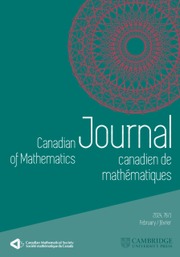No CrossRef data available.
Article contents
On polar convexity in finite-dimensional Euclidean spaces
Published online by Cambridge University Press: 09 December 2024
Abstract
Let  $\hat {\mathbb {R}}^n$ be the one-point compactification of
$\hat {\mathbb {R}}^n$ be the one-point compactification of  $\mathbb {R}^n$ obtained by adding a point at infinity. We say that a subset
$\mathbb {R}^n$ obtained by adding a point at infinity. We say that a subset  $A\subseteq \hat {\mathbb {R}}^n$ is
$A\subseteq \hat {\mathbb {R}}^n$ is  $\mathbf {u}$-convex if for every pair of points
$\mathbf {u}$-convex if for every pair of points  $\mathbf {z}_1, \mathbf {z}_2 \in A$, the arc of the unique circle through
$\mathbf {z}_1, \mathbf {z}_2 \in A$, the arc of the unique circle through  $\mathbf {u}, \mathbf {z}_1$ and
$\mathbf {u}, \mathbf {z}_1$ and  $\mathbf {z}_2$, from
$\mathbf {z}_2$, from  $\mathbf {z}_1$ to
$\mathbf {z}_1$ to  $\mathbf {z}_2$ and not containing
$\mathbf {z}_2$ and not containing  $\mathbf {u}$, is contained in A. In this case, we call
$\mathbf {u}$, is contained in A. In this case, we call  $\mathbf {u}$ a pole of A. When the pole
$\mathbf {u}$ a pole of A. When the pole  $\mathbf {u}$ approaches infinity,
$\mathbf {u}$ approaches infinity,  $\mathbf {u}$-convex sets become convex in the classical sense.
$\mathbf {u}$-convex sets become convex in the classical sense.
The notion of polar convexity in the complex plane has been used to analyze the behavior of critical points of polynomials. In this paper, we extend the notion to finite-dimensional Euclidean spaces. The goal of this paper is to start building the theory of polar convexity and to show that the introduction of a pole creates a richer theory. For example, polar convexity enjoys a beautiful duality (see Theorem 4.3) that does not exist in classical convexity. We formulate polar analogues of several classical results of the alternatives, such as Gordan’s and Farkas’ lemmas; see Section 5. Finally, we give a full description of the convex hull of finitely many points with respect to finitely many poles; see Theorem 6.7.
Keywords
MSC classification
Information
- Type
- Article
- Information
- Copyright
- © The Author(s), 2024. Published by Cambridge University Press on behalf of Canadian Mathematical Society
Footnotes
The second author was partially supported by the Natural Sciences and Engineering Research Council (NSERC) of Canada. (grant RGPIN-2020-06425).


